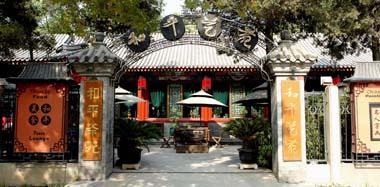Teahouses in Beijing and Shanghai are quite different. Culture and tradition in the two cities makes old things fascinating and comparable.
Best-loved teahouses in Beijing
Tea has been a deeply-rooted part of Chinese life since it first rose to popularity more than 1-thousand years ago, during the Tang Dynasty. There's white tea for spring, green tea for summer, oolong tea for autumn, and black tea for winter. And with tea there are always teahouses popular with locals and visitors alike, from farmers and workers to celebrities. Now we take a closer look at three of the most popular teahouses in Beijing.

Laoshe Tea House
Laoshe Tea House is just a 10-minute walk from Tiananmen square. It's popular both with overseas tourists and locals. In the space of two hours, you can experience the life of old Beijing: sipping cups of tea and munching snacks, while watching a revue of the most popular Chinese traditional performances.
The tea house takes its name from the noted writer Lao She. His drama "Teahouse" is a vivid portrayal of the social dimensions of old Beijing.
Laoshe Teahouse was founded in 1988. It soon became popular for offering "Dawancha" or "big-bowl tea", a tradition that has been running for more than 2 decades. The best part is that the price has never changed. Today, you can still get a refreshing bowl for only two Chinese cents.
Every night features a 90-minute extravaganza. The highlight is the Kungfu tea, a combination of the two Chinese icons. Many wonder why the tea comes in a long-spouted pot. And why it's made of bronze. You'll just have to check it out for yourself at the teahouse.

Peace Art Co
Peace Art Co is descended from the famous Peace Painting Gallery. 50 years ago it was a popular salon favored by literatis and artists. Poet Guo Mouo, painters Xu Beihong and Qi Baishi held regular gatherings here.
An artistic aura still surrounds the building today, though it's now a teahouse. Whether it's the traditional paintings or the decorated screens, Chinese culture is close enough to be touched and felt everywhere.
The first floor resembles a mini-museum, with paintings, calligraphy and old furniture. And the second floor is where you can sip tea and enjoy delicious cuisine with a couple of friends. Chinese dishes or Japanese tea, either will give you a taste of culture.

City Impression Tea House
City Impression Tea House is located in a traditional courtyard of old Beijing. The house used to be the residence of senior officialse in the Ming and Qing Dynasties.
Want to have a taste of Beijingers' life in the old days? At City Impression, you can enjoy the mood, the peace and even the goldfish in the porcelain crock.
Besides an extensive list of teas, City Impression also offers various traditional food and snacks either from the royal palace or from local families. You can also find entertainment in old Beijing games here. They used to be found everywhere there were children, but today are very likely to be found nowhere else.
The tea house holds special celebrations on each of China's traditional festivals. Upholding the old ways of life is one of City Impresson's missions.
We recommend:
